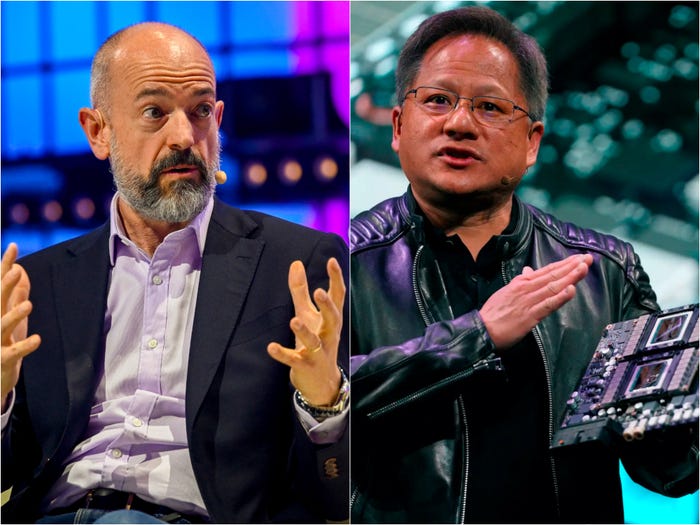In an online talk, Jensen Huang and Simon Segars describe a tech industry growing faster than ever and a combined company that will increase competition and opportunity for all.
With the tech industry facing opportunities at every turn, it’s a ripe moment for NVIDIA’s acquisition of Arm, said CEOs of the companies in a frank conversation with a leading analyst.
Patrick Moorhead of Moor Insights & Strategy posed tough questions and gave the deal a thumbs up in the session at the Six Five Summit.
Sporting a pandemic beard, Arm’s Simon Segars painted the landscape of an industry growing in every direction.
Can’t Do It Alone
“There’s more to do than we have people to do it, that’s always been the case but now it’s more so than ever — more computing is needed in more forms running more complex software frameworks than ever and the applications are limitless,” said Segars in the session recorded at NVIDIA’s Endeavor headquarters in Silicon Valley.
As examples, he cited the deployment of 5G cellular, the electrification of transportation and “the digitization of every part of our lives that’s been accelerated by the experience of the last year.
“There’s no way we can do it all on our own, but through the combination with NVIDIA we will have a lot more resources to create a richer portfolio of IP that fuels the delivery of all these applications yet to come,” he said.
Surfing an AI Sea Change
A sea change in computing is also reshaping the market and opening opportunities for the combined company.
“One of the things people love about this combination is that NVIDIA’s AI technology can be brought out to the far edges of the market where Arm has such a great presence. That’s where the IoT and edge AI is going to happen, but the fundamental technology of AI isn’t out there yet,” said NVIDIA CEO Jensen Huang, wearing a pandemic ponytail.
“The benefits to customers will be more and better IP, more accelerated roadmaps and hopefully taking Arm from the cloud to the edge to IoT and HPC — everything. The breadth of computing today is gigantic,” he said.
Together, NVIDIA and Arm aim to create a platform with broad reach and deep AI capabilities others can build on.
“With this combination, we’ll be able to look at more markets at the same time and go deeper and further up the stack, creating a richer portfolio of IP that companies can then innovate on top of to create even more competitive products — so I think this is great for competition,” Segars said.
Arming for Data Center Diversity
For example, NVIDIA and Arm are well positioned to serve data centers diversifying from hyperscale warehouses to computing closets next to 5G base stations and everything in between, Huang said.
“The thing I love and what Arm enables companies like us to do is design specialized kinds of computers. I believe this open way of enabling diverse computers is exactly the way to go, and we can give it a whole bunch more speed and scale,” he said.
A broader, richer platform from a combined company will fuel and drive down the cost of technology innovation for many others, Segars said.
Frank Answers to Real Questions
Despite its solid rationale, the deal has faced many questions that Moorhead put to the CEOs. For example, will the U.K. remain a tech hub if a jewel like Arm based in Cambridge is acquired by a U.S. company?
Huang called Cambridge “one of world’s premier microprocessor IP and development centers” with a unique capability to balance “super energy-efficient and general-purpose design.
“We have every intention to not only continue that work but invest in doing more of it there,” he pledged.
Specifically, he noted NVIDIA’s $100 million investment in Cambridge-1, an AI supercomputer that will be a resource dedicated to academic and commercial research for healthcare, based at the birthplace of both Arm and genomics. “We want to help the U.K. become a center of world-class AI development,” he said.
No Changes in Export Controls
Addressing another question from Moorhead, Segars explained why the combined company would not face any new export controls.
“Export controls are a function of where a product was created and the nationality of people who worked on it. They have nothing to do with the nationality of the company that owns the product itself,” he said.
“A lot of our products are developed in the U.K., and most are developed outside the U.S. It’s true that U.S. export controls apply to some of our products, but they don’t apply to a lot of our products, and nothing changes when the deal closes,” Segars added.
Moorhead asked Huang about his views on the “Balkanization of the industry” into competing geopolitical camps.
“This is exactly the reason why Arm is popular; it gives you the ability to build your own computer and by extension your own computer industry … but building a vibrant computer industry takes more than a CPU,” Huang replied.
Don’t Equate Independence with Strength
Huang also pointed to what he called the “fallacy of independence” in some criticisms of the deal.
“Some equate independence with goodness, but Simon and I recognize independence is not the same as strength or vibrancy in the ecosystem. Customers want a strong Arm that can go into these wonderful new markets … they want independence with strength,” he said.
Moorhead asked Huang why NVIDIA needs to buy Arm, can’t it just continue to license Arm’s products to build chips like its recently announced NVIDIA Grace CPU?
“We don’t have to buy Arm. NVIDIA is doing well and it has a great strategy. We want to buy Arm because it will expand the reach of the NVIDIA ecosystem and help Arm get into new markets — I’m incredibly excited about sharing our technology with a company that enables millions of devices a day,” Huang replied.
A Full-Stack Company
An AI company needs to be rich in algorithms, software and processor design. “That full-stack approach I advocate is essential in this new world of computing, and we’d love to make our combined capabilities available to licensees,” he added.
Segars agreed. “The opportunity to address all of that is what’s unique in this combination. The definition of everything is getting bigger, and I want to address everything,” he said.
The moderator, a widely respected analyst interviewing a who’s who of tech executives at the event, was clearly convinced.
“What I’m most excited about is the two companies have their own unique superpowers with very little overlap,” Moorhead said.
“I’m excited to see what the two of you can create. There’s not enough competition in some markets, and not enough capability in some markets to really move the rock, but I believe the two of you can do this and I can’t wait to see what will happen,” he added.
You can watch the video (free with registration) here.
Separately, Huang and two other NVIDIA executives gave virtual talks this week at the CogX conference in London.



